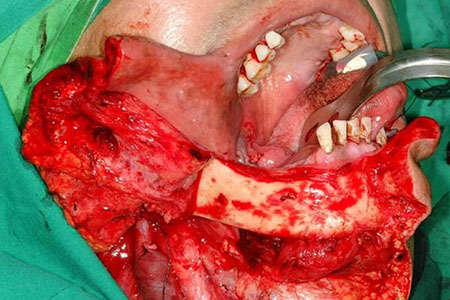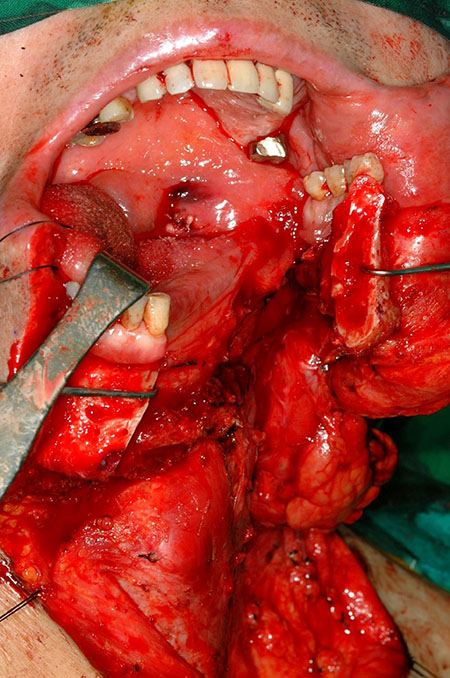Hanyang Med Rev.
2009 Aug;29(3):220-230. 10.7599/hmr.2009.29.3.220.
Surgical Management of Oral Cancer
- Affiliations
-
- 1Department of Otolayngology-Head and Neck Surgery, Collage of Medicine, Hanyang University, Seoul, Korea. kytae@hanyang.ac.kr
- KMID: 1505098
- DOI: http://doi.org/10.7599/hmr.2009.29.3.220
Abstract
- Oral cancer is the sixth most common cancer worldwide. Treatment is directed at the elimination of the primary tumor and neck metastasis with minimal morbidity to the patients. Surgery is the most well established mode of initial definitive treatment for a majority of oral cancer. In spite of a significant paradigm shift in the treatment of many head and neck cancer toward using primary chemoradiation, this treatment is not frequently applied to the oral cavity. Small oral cancers are usually managed by surgery alone. Advanced oral cancers are usually treated with primary surgery followed by radiation. Primary site, location, size, proximity to bone, and depth of invasion are factors which influence a particular surgical approach.
MeSH Terms
Figure
Reference
-
1. Hoffman HT, Karnell LH, Fuck GF, Robinson RA, Menck HR. The national cancer data base report on cancer of the head and neck. Arch Otolaryngol Head Neck Surg. 1998; 124:951–962.
Article2. Rothman K, Keller A. The effect of joint exposure to alcohol and tobacco on risk of cancer of the mouth and pharynx. J Chronic Dis. 1972; 25:711–716.
Article3. Campana JP, Meyers AD. The surgical management of oral cancer. Otolaryngol Clin North Am. 2006; 39:331–348.
Article4. Shah JP, Gil Z. Current concepts in management of oral cancer-Surgery. Oral Oncol. 2009; 45:394–401.5. Shah JP, Patel SG. Head and neck surgery and oncology. 3rd ed. London, New Ypork: Mosby, Edinburgh;2003.6. Shah JP, Candela FC, Poddar AK. The patterns of cervical lymph node metastasis from squamous carcinoma of the oral cavity. Cancer. 1990; 66:109–113.
Article7. Spiro RH, Huvos AG, Wong GY, Spiro JD, Gnecco CA. Predictive value of tumor thickness in squamous cell carcinoma confined to the tongue and floor the mouth. Am J Surg. 1986; 152:345–350.
Article8. Yonemoto R, Ching P, Byron R, Riihimaki D. The composite operation in cancer of the head and neck (Commando procedure). Arch Surg. 1972; 104:809–813.
Article9. Marchetta F, Sako K, Murphy J. The periosteum of the mandible and intraoral carcinoma. Am J Surg. 1971; 122:711–713.
Article10. Brown AE, Langdon JD. Management of oral cancer. Ann R Coll Surg Engl. 1995; 77:404–408.11. Gluckman J, Savoury L. Carcinoma of the oral cavity. In : Paparella M, Shumrik D, Gluckman J, Meyerhoff W, editors. Otolaryngology. 3rd ed. Philadelphia, USA: W.B Sounders Company;1991. p. 2141–2167.12. Eckel H, Volling P, Pototschnig C, Zorowka P, Thumfart W. Transoral resection with staged discontinous neck dissection for oral cavity and oropharynx squamous cell carcinoma. Laryngoscope. 1995; 105:53–60.
Article13. Leemans C, Tiwari R, Nauta J, Snow G. Discontinous vs In-continuity neck dissection in carcinoma of the oral cavity. Arch Otolaryngol Head Neck Surg. 1991; 117:1003–1006.
Article14. LaFerriere KA, Sessions DG, Thawley SE, Wood BJ, Ohura JH. Composite resection and reconstruction for oral cavity and oropharynx cancer. Arch Otolaryngol. 1980; 106:103–110.
Article15. Ward GE, Robben JO. A composite operation for radical neck dissection and removal of cancer of the mouth. Cancer. 1951; 4:98–109.
Article16. Choi EC, Koh YW, Lee YH, Park HJ, Lee KH. Surgical approach to the oral cavity: techniques, advantages and disadvantages of pull through appreach. Korean J Otolaryngol-Head Neck Surg. 2001; 44:89–95.17. Stanley RB. Mandibular lingual releasing approach to oral and orophayrngeal carcinomas. Laryngoscope. 1984; 94:596–600.18. Spiro RH, Gerold FP, Strong EW. Mandibular "swing" approach for oral and oropharyngeal tumors. Head Neck Surg. 1981; 3:371–378.
Article19. Devine JC, Rogers SN, McNally D, Brown JS, Vaughan ED. A comparison of aesthetic, functional and patient subjective outcomes following lip-split mandibulotomy and mandibular lingual releasing access procedures. Int J Oral Maxillofac Surg. 2001; 30:199–204.
Article20. Wang CP, Chang SY, Wu JD, Tai SK. Carbon dioxide laser microsurgery for tongue cancer: surgical technique and long-term results. J Otolaryngol. 2001; 30:19–23.21. O'Malley BW, Weinstein GS, Synder W, NG H. Transoral robotic surgery (TORS) for base of tongue neoplasms. Laryngoscope. 2006; 116:1465–1472.22. Desai SC, Sung CK, Genden EM. Transoral robotic surgery using an image guidance system. Laryngoscope. 2008; 118:2003–2005.
Article23. Weinstein GS, O'Malley BW, Synder W, Sherman E, Quon H. Transoral robotic surgery: radical tonsillectomy. Arch Otolaryngol Head Neck Surg. 2007; 133:1220–1226.24. Larrabee WF, Sherris DA. Lips and chin. Principles of facial reconstruction. Philadelphia, USA: Lippincott-Raven;1995. p. 170–219.25. Langstein HN, Robb GL. Lip and perioral reconstruction. Clin Plast Surg. 2005; 32:431–445.
Article26. Jeng SF, Kuo YR, Wei FC, Su CY, Chien CY. Reconstruction of extensive composite mandibular defects with large lip involvement by using double free flaps and fascia lata grafts for oral sphincters. Plast Reconstr Surg. 2005; 115:1830–1836.
Article27. Wong TY, Chung CH, Huang JS, Chen HA. The inverted temporalis muscle flap for intraoral reconstruction: its rationale and the results of its application. J Oral Maxillofac Surg. 2004; 62:667–675.
Article28. Alonso del Hoyo J, Fernandez Sanroman J, Gil-Diez JL, Diaz Gonzalez FJ. The temporalis muscle flap: an evaluation and review of 38 cases. J Oral Maxillofac Surg. 1994; 52:143–147.
Article29. Lopez R, Dekeister C, Sleiman Z, Paoli JR. The temporal fasciocutaneous island flap for oncologic oral and facial reconstruction. J Oral Maxillofac Surg. 2003; 61:1150–1155.
Article30. Vartanian JG, Carvalho AL, Carvalho SM, Mizobe L, Margin J, Kowalski LP. Pectoralis major and other myofascial/myocutaneous flaps in head and neck cancer reconstruction: experience with 437 cases at a single institution. Head Neck. 2004; 26:1018–1023.
Article31. Disa JJ, Liew S, Cordeiro PG. Soft-tissue reconstruction of the face using the folded/multiple skin island radial forearm free flap. Ann Plast Surg. 2001; 47:612–619.
Article32. Mehta RP, Deschler DG. Mandibular reconstruction in 2004: an analysis of different techniques. Curr Opin Otolaryngol Head Neck Surg. 2004; 12:288–293.
Article33. Deschler DG, Hayden RE. The optimum method for reconstruction of complex lateral oromandibular-cutaneous defects. Head Neck. 2000; 22:674–679.
Article34. Urken ML, Buchbinder D, Costantino PD, Sinha U, Okay D, Lawson W, Biller HF. Oromandibular reconstruction using microvascular composite flaps: report of 210 cases. Arch Otolaryngol Head Neck Surg. 1998; 124:46–55.
Article35. Antoniades K, Lasaridis N, Vahtsevanos K, Hadjipetrou L, Antoniades V, Karakasis D. Superiorly based and island masseter muscle flaps for repairing oropharyngeal defects. J Craniomaxillofac Surg. 2005; 33:334–339.
Article36. Genden EM, Lee BB, Urken ML. The palatal island flap for reconstruction of palatal and retromolar trigone defects revisited. Arch Otolaryngol Head Neck Surg. 2001; 127:837–841.37. Thomson CJ, Allison RS. The temporalis muscle flap in intraoral reconstruction. Aust N Z J Surg. 1997; 67:878–882.
Article38. Genden EM, Wallace DI, Okay D. Reconstruction of the hard palate using the radial forearm free flap: indications and outcomes. Head Neck. 2004; 26:808–814.
Article39. Hara I, Gellrich NC, Duker J, Schon R, Fakler O, Smelzeisen R, Honda T, Satoru O. Swallowing and speech function after intraoral soft tissue reconstruction with lateral upper arm free flap and radial forearm free flap. Br J Oral Maxillofac Surg. 2003; 41:161–169.
Article40. Netscher D, Armenta AH, Meade RA, Alford EL. Sensory recovery of innervated and noninnervated radial forearm free flaps: functional implications. J Reconstr Microsurg. 2000; 16:179–185.
Article






